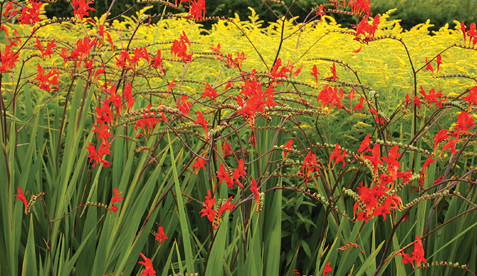By August, one of the showiest plants of the late growing season will begin spreading its bright yellow glow across fields, meadows, landscapes and gardens. Unfortunately, it also happens to be a very misunderstood plant. It’s goldenrod (Solidago sp.).
Mention goldenrod and many sufferers of hay fever will brace themselves to get ready for a big “A-A-A-CHOO-O-O!” because the pollen from its flowers will make you sneeze, right?
 Wrong. Examine the pollen on a cluster of goldenrod blooms and you will find that it is not light enough to become wind-borne and drift up the snoot. What is happening is that the inconspicuous blossoms of ragweed open about the same time with pollen that can easily fly away in the slightest breeze to aggravate sensitive noses. So the real culprit is ragweed, but the showy blooms of goldenrod usually get the blame.
Wrong. Examine the pollen on a cluster of goldenrod blooms and you will find that it is not light enough to become wind-borne and drift up the snoot. What is happening is that the inconspicuous blossoms of ragweed open about the same time with pollen that can easily fly away in the slightest breeze to aggravate sensitive noses. So the real culprit is ragweed, but the showy blooms of goldenrod usually get the blame.
Long considered a “ditch weed” by many American gardeners, goldenrod has been embraced by European growers for centuries. For instance, at the magnificent Culzean Castle gardens on the Ayrshire coast of Scotland, large swaths of goldenrod form the perfect backdrop to make a large bed of ‘Lucifer’ crocosmia with its simmering red blooms really pop. Even the Impressionist painter Claude Monet couldn’t resist planting goldenrod, and this bright plant with blossoms the color of sunshine still resides in his famous gardens at Giverny, France.
These days, however, goldenrod has finally begun finding its pretty way into American gardens, and why not? Its show-stopping flower panicles are long-lasting, and the tough-as-nails plants require little maintenance. In addition, goldenrod comes into its blooming prime deep in the summer when many other flowering plants begin to fade from the heat.

Left – More than a “ditch weed,” goldenrod is a bright light of a plant worthy for any late summer garden.
Right – Goldenrod mixing it up with other plants in Claude Monet’s garden in Giverny, France.
A hardy perennial, goldenrod can be planted anytime, but late summer and early fall are ideal times. For the best blooms, place the plants in an area that receives as much full sun as possible. Depending on the species (and there are about 150), goldenrods can grow from 1 to 5 feet tall. Pinching back the tips in late spring will promote bushier growth and a fuller display of flowers.
And for a little variety, there are even goldenrod cultivars being offered by nurseries. ‘Firepower’ is an eye-catching selection introduced by the N.C. Botanical Garden in Chapel Hill that packs bunches of bright blooms on stately, 3- to 4-foot plants. ‘Golden Fleece’ was discovered in a North Carolina garden, and this compact, 18-inch-tall goldenrod gets high marks for its gracefully arching flower clusters. And for more fluff on a slightly larger plant, try the plume-like panicles of the 24-inch-tall ‘Crown of Rays’.
A typical planting scheme for goldenrod is to complement it with other native flowers that bloom at the same time, and a classic combination bounces the flowers’ bright yellow rays off of the pretty purples of ironweed or New England aster. Also, since goldenrod is also a favorite with many butterflies, it will always attract these flits of kinetic color into the garden.
A weed, indeed — goldenrod should be considered an outstanding native plant instead. It is a tough, dependable performer that brings the brightest of yellows to the garden during the hottest of times. It is a beauty that truly makes the waning days of summer golden.
L.A. Jackson is the former editor of Carolina Gardener magazine. If you would like to ask him a question about your garden, go to his website at: southeastgardening.com.







